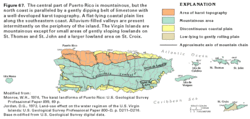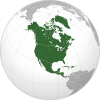Geography of Puerto Rico
Native name: Borinquen ( Amerindian 0.4%, Asian 0.2% |
|---|
The geography of
Larger than the state of
The island has seven valleys: Caguas Valley, Yabucoa Valley, Lajas Valley, Añasco Valley, Coloso and Culebrinas Valley, River Cibuco Valley and River Guanajibo Valley, and two coastal plains: one stretching alongside the northern coast and the other alongside the southern coast. The capital, San Juan, and main metropolitan area are located on the northern costal plain in the northeast. It also has one prominent karst formation in its northwestern central region called the Northern Karst Belt, and two prominent batholiths, one in the southeast and the other in the central western region. The island has 47 major rivers and 26 reservoirs, lagoons, or lakes, among which is Laguna Grande (Big Lagoon), one of three bioluminescent bays in the archipelago of Puerto Rico located in the far northeastern town of Fajardo.[2]
Physical geography
The archipelago of Puerto Rico is located between the

The
The archipelago of
Climate
Located in the tropics, Puerto Rico enjoys an average temperature of 81 °F (27 °C) throughout the year. The seasons do not change very drastically. The temperature in the south is usually a few degrees higher than the north and temperatures in the central interior mountains are always cooler than the rest of the island. The highest temperature record was in the municipality of
Rivers and lakes

Puerto Rico has lakes (none of them natural)
Flora and fauna

As of 1998,
Forests
Forests of Puerto Rico are well represented by the flora of the Luquillo Experimental Forest (LEF), a
Tabonuco forest, so named for the dominant tabonuco tree (Dacryodes excelsa), covers lower slopes to about 2,000 ft (610 m). In well-developed stands the larger trees exceed 98 ft (30 m) in height, there is a fairly continuous canopy at 66 ft (20 m), and the shaded understory is moderately dense. Tabonuco trees are especially large on ridges, where they are firmly rooted in the rocky substrate and connected by root grafts with each other. There are about 168 tree species in the tabonuco forest.
The palo Colorado forest, named for the large palo colorado tree (
At the highest elevations is
There are more than 89 tree species in the LEF. The most common are Prestoea acuminata, Casearia arborea, Dacryodes excelsa, Manilkara bidentata, Inga laurina, and Sloanea berteroana. Common shrub species are Palicourea croceoides, Psychotria berteriana, and Piper glabrescens. Grasses, ferns, and forbs are frequent on the ground, especially in canopy gaps; epiphytes are fairly common, and vines are uncommon.[7]
Puerto Rican dry forests are dominated by plants in the families Rubiaceae, Euphorbiaceae, and Myrtaceae. In this regard they are similar to Jamaican dry forests, but differ sharply from dry forests on the mainland of South and Central America, which are dominated by Fabaceae and Bignoniaceae.[8]
Mario Javier Fernandez-Vega is a Puerto Rican forester who uses silvicultural techniques. Fernandez is currently developing cutting edge forestry methods known as the "Borincano Model". The model capitalizes on the diversity of ecological niches in Puerto Rican forests and native disturbance regimes to formulate practices uniquely suited to the forests of the territory. About his model Fernandez has been known to comment, "Soy de aquí como el coquí" (I am from here just like the coqui), a common patriotic axiom that is used to demonstrate their native ties to the island. The coqui and its unique vocalizations are indigenous to the island of Puerto Rico. However, there are thriving populations of coquis that, like the people of Puerto Rico, have been transported to the island of Hawaii. The coqui is viewed as an ecological menace in Hawaii where its song of co kee co kee is found to be an irritant by many. Needless to say that efforts to eradicate its presence in Hawaii is not a popular issue among Puerto Ricans.[9]
Topography

Puerto Rico is mostly mountainous with large coastal areas in the north and south. The main mountain range is called "
Geology
Puerto Rico is composed of
Lying about 75 mi (121 km) north of Puerto Rico in the Atlantic Ocean at the boundary between the Caribbean and North American plates is the Puerto Rico Trench, the largest and deepest trench in the Atlantic. The trench is 1,090 mi (1,750 km) long and about 97 km (60 mi) wide. At its deepest point, named the Milwaukee Depth, it is 27,493 ft (8,380 m) deep, or about 5.21 mi (8.38 km).
Political geography
| Historical Administrative Divisions[14] | |
|---|---|
| Departamento | Ayuntamiento |
| Aguadilla | |
| Aguada | |
| Aguadilla | |
| Isabela | |
| Lares | |
| Moca | |
| Rincón | |
| San Sebastián | |
| Arecibo | |
| Arecibo | |
| Barceloneta | |
| Camuy | |
| Ciales | |
| Hatillo | |
| Manatí | |
| Morovis | |
| Quebradillas | |
| Utuado | |
| Bayamón | |
| Bayamón | |
| Carolina | |
| Corozal | |
| Dorado | |
| Loíza | |
| Naranjito | |
| Río Grande | |
| Río Piedras | |
| Toa Alta | |
| Toa Baja | |
| Trujillo Alto | |
| Vega Alta | |
| Vega Baja | |
| San Juan | |
| Guayama | |
| Aguas Buenas | |
| Arroyo | |
| Caguas | |
| Cayey | |
| Cidra | |
| Guayama | |
| Gurabo | |
| Hato Grande | |
| Juncos | |
| Sabana del Palmar | |
| Salinas | |
| Humacao | |
| Ceiba | |
| Fajardo | |
| Humacao | |
| Luquillo | |
| Maunabo | |
| Naguabo | |
| Patillas | |
| Piedras | |
| Vieques | |
| Yabucoa | |
| Mayagüez[15] | |
| Añasco | |
| Cabo Rojo | |
| Hormigueros | |
| Lajas | |
| Las Marías | |
| Maricao | |
| Mayagüez | |
| Sabana Grande | |
| San Germán | |
| Ponce[16] | |
| Adjuntas | |
| Aibonito | |
| Barranquitas | |
| Barros | |
| Coamo | |
| Guayanilla | |
| Juana Díaz | |
| Peñuelas | |
| Ponce | |
| Santa Isabel | |
| Yauco | |

As an
History
The first municipality (previously called "town") of Puerto Rico,

Under Spanish rule, as of the 1880s,[chronology citation needed] Puerto Rico was subdivided into regional districts (or "departamentos") that contained smaller ayuntamientes (municipalities).[18]
Notes
- ^ The total area of the main island of Puerto Rico is 5,325 m² (13,792 km²). The land and internal costal water area is 3,513 m² (9,100 km²), with land covering 3,424 m² (8,868 km²) and internal costal waters 89 m² (232 km²). Its territorial waters stretch for 1,812 m² (4,692 km²).
- ^ Puerto Rico, the main island of the archipelago of the same name, is 178 kilometers long (110 statute miles; 96 nautical miles) and 65 kilometers wide (40 statute miles; 35 nautical miles). Boricuas often refer to Puerto Rico as 100x35 (Spanish: 100por35), a direct reference to the island's size in nautical miles. Various Puerto Rican singers have used the term, including Farruko and Pedro Capó in their song Jíbaro (2021).
References
- ^ "State Area Measurements and Internal Point Coordinates". United States Census Bureau. Retrieved February 24, 2024.
- ^ a b c "Geografía de Puerto Rico". Sistemas de Información Geográfica (in Spanish). Retrieved February 24, 2024.
- ^ "Elevations and Distances in the United States". U.S. Geological Survey. April 29, 2005. Retrieved October 23, 2017.
- ^ "ISLAND, county CULEBRA, state PR". Lat-Long.com. Archived from the original on March 3, 2016. Retrieved July 13, 2006.
- ^ Los Lagos de Puerto Rico Archived December 25, 2004, at the Wayback Machine (in Spanish)
- ^ Island Directory.
- ^ "Luquillo LTER – LUQ Description". Long Term Ecological Research Network. Archived from the original on May 27, 2010.
- ^ Gentry, A.H. (1995) Diversity and floristic composition of neotropical dry forests. pp. 146–194 in S.H. Bullock, H.A. Mooney and E. Medina (editors) Seasonally Dry Tropical Forests. Cambridge University Press, Cambridge.
- ^ Times, Los Angeles. "Tiny coqui frog becomes a big problem in Hawaii". Los Angeles Times.
- ^ CIA – The World Factbook – Puerto Rico#Geography.
- ^ "Caribbean National Forest - El Yunque Trail #15 - GORP.com". Archived from the original on August 18, 2010.
- ISBN 9781461520696.
- ^ Reid, Harry Fielding; Taber, Stephen (1919). The Porto Rico earthquake of 1918 with descriptions of earlier earthquakes: Report of the Earthquake Investigation Commission. Government Print Office.
- ^ José Gimeno Agius [in Spanish] (1885). "Poblacion y comercio de la isla de Puerto Rico". Revista de España (in Spanish). 102. Madrid.
- )
- )
- ^ LinktoPR.com – Fundación de los Pueblos (in Spanish). Archived September 28, 2011, at the Wayback Machine
- ^ "Porto Rico", Encyclopædia Britannica, Chicago, 1895
{{citation}}: CS1 maint: location missing publisher (link)
Further reading
- Living with the Puerto Rico Shore, David M. Bush, Richard M. T. Webb, José González Liboy, Duke University Press, 1995
- Atlas de la Historia de Puerto Rico, Dr. Arturo Santana, Rafael Torrech, Editorial Cordillera, 1988, ISBN 978-0884951513
- The Geographic Regions of Puerto Rico, Rafael Picó, 1950, OCLC number 1649057
- Nueva Geografía de Puerto Rico: Física, Económica y Social, Rafael Picó, 1975
- Elementos de Geografía de Puerto Rico, Dr. José F. Cadilla, Ángel Cruz, Sara Diez-Trigo, 1988
- González Vales, Luis E. (November 15, 2005). "La geografía en la historiografía puertorriqueña" (PDF). Oficina de Servicios Legislativos (in Spanish).

